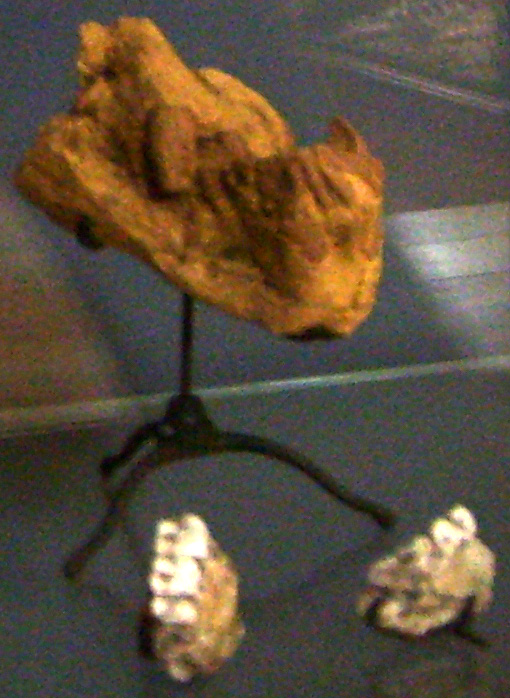- Kenyapithecus wickeri
Taxobox
name = "Kenyapithecus wickeri"
fossil_range = middleMiocene

image_width = 250px
image_caption = "Kenyapithecus wickeri" fossils,Muséum national d'histoire naturelle , Paris
regnum =Animal ia
phylum =Chordata
classis =Mammal ia
ordo =Primates
superfamilia =Hominoidea
familia =Hominidae [ Ward, S.C. and Duren, D. L. (2002) "Middle and Late Miocene African Hominoids". In Hartwig, W.C. ed. The Primate Fossil Record. Cambridge University Press ]
subfamilia = †Kenaypithecinae
genus = †"Kenyapithecus"
species = "K. wickeri"
binomial = †"Kenyapithecus wickeri"
binomial_authority = Leakey, 1962"Kenyapithecus wickeri" was a
fossil ape discovered byLouis Leakey in 1961 at a site calledFort Ternan inKenya . Theupper jaw andteeth were dated to 14 million years ago. One theory states that "Kenyapithecus" may be the common ancestor of all thegreat ape s. More recent investigations suggest "Kenyapithecus" is more primitive than that and is only slightly more modern than when "Proconsul" is considered to be an ape.Evidence suggests that "Kenyapithecus wickeri" was one of the species that started a radiation of apes out of
Africa .Morphology
Impressed by "Kenyapithecus"'s modern-looking teeth, Leakey declared "Kenyapithecus" to be "a very early ancestor of man himself." (Science August 27 1999, Carl Zimmer)
"Kenyapithecus" possessed craniodental adaptations for hard object feeding including thicker molar
enamel , and a largemandible , largepremolars and upperincisors that are similar to those seen in livingpitheciine monkeys [ Fleagle, J. G. (1999) Primate Adaptation and Evolution. Elsevier Academic Press ] "Kenyapithecus" also possessed macaque-like limbs adapted for aknuckle-walking mode of semi-terrestriallocomotion [ McCrossin ML,Benefit, BR Gitau, SN Palmer, AK Blue, KT. (1998) Fossil evidence for the origins of terrestriality among Old World higher primates. Primate locomotion: recent advances. New York: Plenum Press. p 353-396 ] This could show that ashominins evolved, they passed through a knuckle-walking phase."Kenyapithecus wickeri" has very distinct features, especially details in the
canine teeth and is similar to modern apes.References
External links
*http://www.sciencedaily.com/releases/1999/08/990831080717.htm
*http://www.nmsu.edu/~anthro/monte_mccrossin.htm
*http://www.geocities.com/SoHo/Atrium/1381/hominids1.html
*http://www.mc.maricopa.edu/~reffland/anthropology/anthro2003/origins/primates/primate_evol/miocene.html
*http://64.233.167.104/search?q=cache:VnLGT_wKX8gJ:rcp.missouri.edu/carolward/pdfs/quotezimmer.doc+Kenyapithecus+wickeri&hl=en
* [http://www.fmnh.helsinki.fi/users/haaramo/Metazoa/Deuterostoma/Chordata/Synapsida/Eutheria/Primates/Hominoidea/hominoidea.htm Mikko's Phylogeny archive]
Wikimedia Foundation. 2010.
